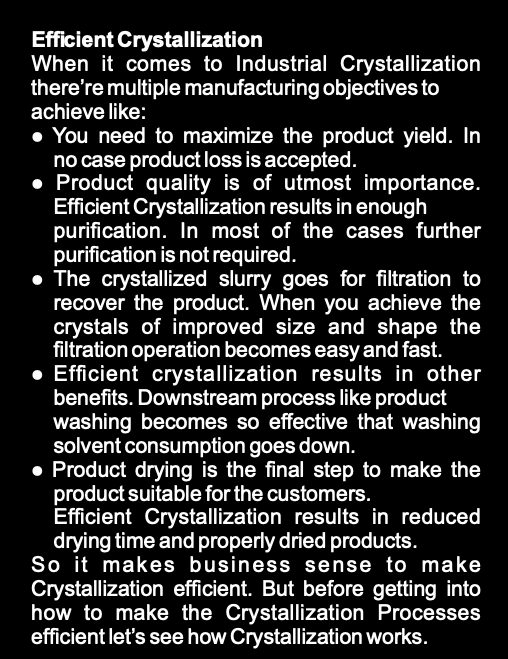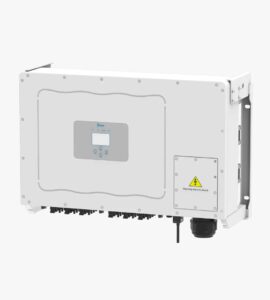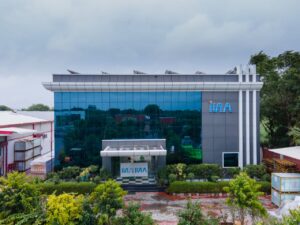 By- Mr. Rasa Bihari Mishra | +91 84696 27669 | rbm.innovations@gmail.com
By- Mr. Rasa Bihari Mishra | +91 84696 27669 | rbm.innovations@gmail.com
Think of the solid products you’re using in daily basis like sugar or common salt. They’re different. One substance is organic while the other is inorganic. But there’s one similarity. How? Because both of them are manufactured using Crystallization process. In fact most of the solid products especially those which are made in Chemical, Pharmaceutical, and other Process Industries are manufactured by using Crystallization process. Crystallization is the most used Separation Process to Recover Solid Products from the Solution.
That’s the reason why it becomes necessary to make the industrial Crystallization processes efficient.

Crystallization Process
The aim of the crystallization process is to recover the product from the solution selectively. Why?
Because the product is there in dissolved condition along with other undesirable compounds. That’s why selective separation becomes necessary to get rid of the undesirable compounds.
Crystallization takes the advantage of reducing the solubility of the product by changing the physical and chemical parameters. The solution gets supersaturated and the product becomes insoluble and comes out of the solution leaving behind the undesirable compounds. So you get the solid product in pure form.
Sometimes people prefer to call it precipitation
especially when the process happens due to the reactions. In industrial crystallization once the crystallization is over slurry forms. The slurry consists of the product solids suspended in the solvent. Of course the solvent is no longer pure now. Many compounds are dissolved in it. The product solids are separated by using filtration or centrifugation. But still the solid particles are coated with the filtrate loaded with undesired compounds. So the solid particles are washed with suitable solvent to remove the filtrate and make the products pure.
The washed solids are in wet condition. They’re not free from the solvents. So drying operation is necessary to remove the solvents and make them dry. A wide variety of crystallization processes are used in the industry. These are nothing but using various ways to make the solution supersaturated. Because they use different supersaturation methods to reduce the solubility of the product in the solvent. Since the supersaturation methods are different it’s better to evaluate them separately.
Cooling Crystallization
The solubility of the substances depend on the tem- perature. The solubility of most of the compounds are lower at lower temperatures. So when you cool the solution it gets supersaturated and the products get crystallized out. You need to effective heat transfer process to lower down the temperature. And hence efficient heat transfer system is important here.
Cooling crystallization process is used for a wide number of products. Both continuous and batch mode of operations are utilized. A wide number of technologies are in operation.
Evaporative Crystallization
The solubility of a chemical compound in a solvent is constant at a certain temperature. When you remove the solvent by evaporation the solution gets concentrated. As the quantity of product dissolved in the Solution depends on the quantity of solvent, the solution gets supersaturated. And the product get insolubilized and crystallize out of the solution.
You need to use Evaporation system to evaporate the solution. And that’s why efficient evaporation system becomes necessary. Evaporative crystallization process are used in many places. Both continuous and batch mode of operations are utilized. A wide number of technologies are available to select from. Usage of Precipitants The solubility of chemical compound changes drastically when they get interacted with different types of chemical substances. We call them Precipitants. Some precipitants react with the product molecules. Some precipitants form adduct with the product molecules. Some precipitants alter the solubility of the product molecule significantly by common ion effect. Precipitant addition results in significant reduction in the solubility. The solution gets supersaturated and the products get crystallized out. With batch manufacturing processes you need to use mixing vessel with good agitation to avoid dead zones for making the process efficient.
pH Adjustment
Most of the chemical compounds become electrically neutral at certain pH based on the presence of acidic and basic groups in the molecule. At that pH the solubility of the compounds become minimum. That’s what is gainfully utilized in many crystallization processes.
You need to add suitable acid or alkali to take the pH of the solution to the Isoelectric point, where the product molecule becomes electrically neutral. Because of significant reduction in the solubility of the product molecule, the solution gets supersaturated and the product gets crystallized out.
With batch manufacturing processes you need to use mixing vessel with good agitation to avoid dead zones and achieve uniform pH in the crystallizer. It helps in making the process efficient.
Anti-Solvent Addition
The solubility of chemical compounds depend on the type solvents in which the molecules are dissolved. Solvents are different as far as their ability to dissolve the compounds in them is concerned. When you mix certain solvents in which the product molecules have no solubility or very less solubility, the overall solubility situation changes drastically. We call these solvents to be Anti-Solvents.
You need to ensure that the solvents you are using for precipitation are miscible in the solvent in which the product is dissolved. Then only the process will be effective. When you add suitable anti solvents (water included) the product solution the solubility of the product decreases resulting in supersaturation. So the product gets crystallized out. With batch manufacturing processes you need to use mixing vessel with good agitation to avoid dead zones and uniform solvent concentrations for the precipitation process to succeed.
Sometimes no single supersaturation method becomes effective. In that case you may have to use multiple supersaturation techniques in order to make the crystallization processes efficient.
Before getting into the details of how we can enhance the crystallization operation, let’s understand what really happens inside the crystallizer. Two major events happens which decide the outcome of the crystallization process.
-Crystallization Nucleation
-CrystalGrowth
Let’s discuss about them…
Crystallization Nucleation
When you make the solution – in which your product is dissolved – supersaturated, the product starts getting insoluble. In the initial phase of supersaturation some crystals or precipitates come out of the solution. We call them nuclei and the process crystallization Nucleation. In that initial phase the size of the solid particles are smaller. In fact with time the size increases. That’s what happens in the next phase of the crystallization process-crysta growth.
Crystal Growth
Once nuclei forms in the crystallization process, the insoluble products coming out of the solution start getting deposited on them. When the crystallization rate is not very high this results in crystal growth and you get crystals of proper size and shape.
Sufficient time for crystal growth helps in the process.
But when the supersaturation rate is very high the situation becomes different. There’s not enough time for crystal growth. It results in small crystals of improper size and shape. And when the supersaturation rate is so high that the crystallization is instantaneous, only nuclei forms. That’s why it results in the formation of products of amorphous nature. As we have discussed above in order to improve the crystallization efficiency you need to focus on nucleation and the crystal growth. Optimize the Supersaturation The crystallization process solely depends on the supersaturation. Supersaturation decides the outcome of crystallization. Irrespective of what you are doing for making the solution supersaturated, the rate and extent of supersaturation need to match with the requirements.
Product Yield and Quality
When you talk about the product yield and product quality in crystallization process the situation becomes challenging. Why? Because the Crystallization is a selective process. You’re separating the products from the solution in solid form selectively. You want the products but not the impurities.
When you reduce the product solubility to a very extent you may be able to achieve high product yield. But if the undesirable compounds get crystalize out of the solution the product quality will suffer. So here the selectivity matters.
So you need to optimize the solvent as well as supersaturation methods to achieve both high product yield and improved product quality. If consider the product quality many quality attributes depends on the rate of super saturation. Again the rate of supersaturation will depend on the supersaturation method. So you need to go for detailed optimization considering all the technical and business aspects. The idea is to match the manufacturing process with the customer requirements efficiently.
Let’s Conclude
As we have discussed crystallization is one of the most important separation process to get the products in solid form. That’s why it’s extensively used in Chemical, Pharmaceutical and other Process Industries.
In order to make the manufacturing efficient you need to optimize the separation processes. But the processes are interdependent. That’s why an integrated approach becomes effective. And so close coordination between the production, process development, quality, process engineering and sales & marketing functions becomes necessary.
-Detailed Evaluation and Monitoring of the Manufacturing Processes are important.
-Carrying out Detailed Mass and Energy Balance Study can help
-You can initiate an Integrated Technical Evaluation & Enhancement to Optimize
the Separation Processes.
-Conducting periodic Technical Training Programs can help in making the industry professionals knowledgeable. It’ll help them in not only operating the plant efficiently but also making significant contributions in the organizational growth.
In today’s competitive business environment it’s essential to give utmost importance to the improvement initiatives and finding creative solutions to industrial problems. Implementing Technical Innovations in a structured way can help a lot.






